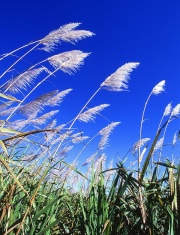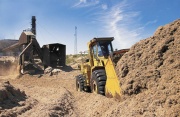Difference between revisions of "Bagasse"
JMcGlinchey (talk | contribs) |
|||
| Line 13: | Line 13: | ||
Dust is flammable. Inhalation of dust may cause pneumonitis or asthma. | Dust is flammable. Inhalation of dust may cause pneumonitis or asthma. | ||
| + | |||
| + | == Additional Properties == | ||
| + | Paper fiber type: Non-woody/grass. Using transmitted light microscopy, fibers are flat and thick-walled with mostly blunt ends. The have the appearance of hardwood fibers. Parenchyma cells are very large, thin-walled and abundant. Heavily pitted long vessels are also present, but may be broken up by pulping. Separated spiral thickenings may be presnet . Appearance with Graff's C-Stain: Dark blue, but varies with bleaching . Average dimensions of fibers: length, 1.7mm; width 20μm. Common pulping method: mechanical or soda. | ||
== Additional Images == | == Additional Images == | ||
| Line 46: | Line 49: | ||
* Art and Architecture Thesaurus Online, http://www.getty.edu/research/tools/vocabulary/aat/, J. Paul Getty Trust, Los Angeles, 2000 | * Art and Architecture Thesaurus Online, http://www.getty.edu/research/tools/vocabulary/aat/, J. Paul Getty Trust, Los Angeles, 2000 | ||
| + | * Marja-Sisko Ilvessalo-Pfäffli. ''Fiber Atlas: Identification of Papermaking Fibers'' (Springer Series in Wood Science). Springer, 1995. | ||
[[Category:Materials database]] | [[Category:Materials database]] | ||
Revision as of 17:15, 15 August 2014
Description
Originally, the term bagasse was applied to any residual fibers from the processing of numerous plants and fruits such as olives, palm nuts, grapes, Sisal, sugarcane, and sugar beets. Currently, the term bagasse only refers to the dry, fibrous residue left from the stalks of sugarcane, Saccharum officinarum, after the sugar has been extracted. Bagasse is composed of Cellulose (50%), pentosan (25%) and Lignin (25%). It is used in the production of Paper pulp, fiberboards, Insulation, Acoustical tile, and animal feed.
Synonyms and Related Terms
megass; bagazo (Esp.); Saccharum officinarum (sugarcane)
Hazards and Safety
Dust is flammable. Inhalation of dust may cause pneumonitis or asthma.
Additional Properties
Paper fiber type: Non-woody/grass. Using transmitted light microscopy, fibers are flat and thick-walled with mostly blunt ends. The have the appearance of hardwood fibers. Parenchyma cells are very large, thin-walled and abundant. Heavily pitted long vessels are also present, but may be broken up by pulping. Separated spiral thickenings may be presnet . Appearance with Graff's C-Stain: Dark blue, but varies with bleaching . Average dimensions of fibers: length, 1.7mm; width 20μm. Common pulping method: mechanical or soda.
Additional Images
Authority
- R. J. Gettens, G.L. Stout, Painting Materials, A Short Encyclopaedia, Dover Publications, New York, 1966
- Richard S. Lewis, Hawley's Condensed Chemical Dictionary, Van Nostrand Reinhold, New York, 10th ed., 1993
- Boise Cascade Paper Group, The Paper Handbook, Boise Cascade, Portland OR, 1989
- Matt Roberts, Don Etherington, Bookbinding and the Conservation of Books: a Dictionary of Descriptive Terminology, U.S. Government Printing Office, Washington DC, 1982
- The Dictionary of Paper, American Paper Institute, New York, Fourth Edition, 1980
- E.J.LaBarre, Dictionary and Encyclopedia of Paper and Paper-making, Swets & Zeitlinger, Amsterdam, 1969
- Random House, Webster's Encyclopedic Unabridged Dictionary of the English Language, Grammercy Book, New York, 1997
- The Merck Index, Martha Windholz (ed.), Merck Research Labs, Rahway NJ, 10th edition, 1983 Comment: entry 970
- The American Heritage Dictionary or Encarta, via Microsoft Bookshelf 98, Microsoft Corp., 1998
- Encyclopedia Britannica, http://www.britannica.com Comment: "bagasse" Encyclopædia Britannica [Accessed September 19, 2001].
- Art and Architecture Thesaurus Online, http://www.getty.edu/research/tools/vocabulary/aat/, J. Paul Getty Trust, Los Angeles, 2000
- Marja-Sisko Ilvessalo-Pfäffli. Fiber Atlas: Identification of Papermaking Fibers (Springer Series in Wood Science). Springer, 1995.



